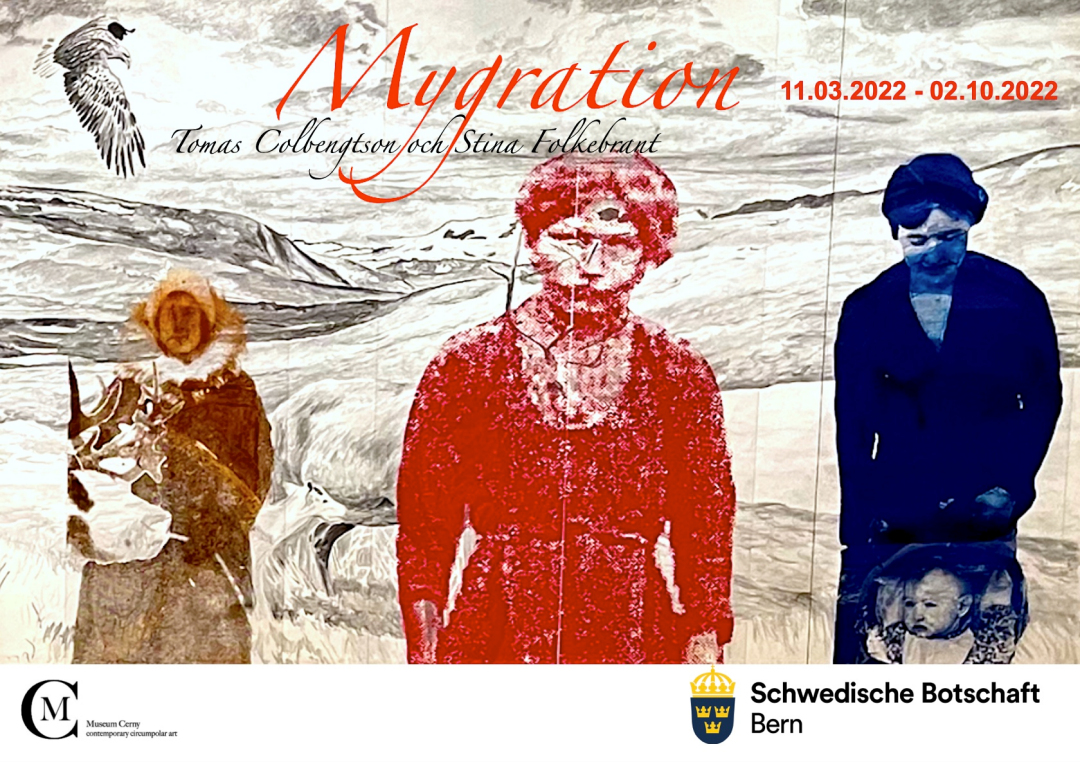
Mygration is the result of an artistic collaboration between Stina Folkebrant and Tomas Colbengtson. The source of inspiration for this exhibition is the emigration of Sami and reindeer around 1900 from northern Scandinavia to Canada and Alaska.
The Klondike Gold Rush, which began in 1896, was one of the most momentous major events of its kind. More than 100,000 people flocked to the area in northern Canada and Alaska. This led to the demarcation of the border between the U.S. and Canada, had widespread negative consequences for indigenous populations and the environment, and also created numerous logistical problems. How was the supply of food and equipment to the prospectors to be ensured? How to remove the mined gold? Animal breeding was hardly possible in the cold area, horses could not be used as beasts of burden in the deep snow. At the same time, Canada and the U.S. were working to settle the indigenous populations of these areas.

For this purpose, Sami from Scandinavia were brought to the North American Arctic with their reindeer at the beginning of the 1890s. In addition to supplying the gold miners, they were to teach the local populations how to herd reindeer. The project was successful. By 1920, the Sami and their apprentices had established 98 herds in Alaska with an estimated 600,000 reindeer. Under the Reindeer Act of 1937, Alaska’s white population lost the right to own reindeer. The Sami, who form the indigenous population of Scandinavia in Europe but are immigrants from Europe in North America, were also considered “white.” Deprived of their livelihood and robbed of a central part of their culture, some disillusioned moved back to Scandinavia, others migrated to other parts of the United States.

The people depicted in the works of Sami artist Tomas Colbengtson are anonymous Sami and Inuit who were photographed in the late 19th and early 20th century in Sapmi and Alaska. Swedish artist Stina Folkebrant paints large-scale depictions of nature in black and white.

The fact that her painting has perhaps a more obvious connection to traditional Chinese ink painting than to our notions of contemporary art means that she is often not placed in the latter category. Tomas Colbengtson also does not conform to the most common notions of a Sami artist, as he often prints photographs on glass; neither the technology nor the material have a place in “traditional” Sami art. The content focus of his art for most of his career is clearly outside of what we understand as “contemporary.”

Stina Folkebrant was born and raised in Borås, but now lives in Stockholm and has her studio in Gustavsberg harbor, east of Stockholm. She studied art and religious studies at Stockholm University. Her focus was on Zen painting during the Sung Dynasty in China.
Stina paints with acrylic in black and white, inspired by Chinese ink painting, where the black paint is mixed with water to create a gray scale. With some distance, the paintings can be perceived as very realistic, but when you get closer to them, the brushwork becomes visible and the contours come alive. She paints mostly on canvas up to 3 x 4.50 meters, but also old bed sheets and screens. In addition, murals by her can be found in Stockholm, Borås, Linköping, Oskarshamn and Västervik, among other places. She has numerous national and international solo exhibitions to her credit.
Stina is the 2022 Artist in Residence at the Women’s International Study Center in Santa Fe and the National Nordic Museum in Seattle.
Link to the website of Stina Folkebrant

Tomas Colbengtson is a southern Sami, born and raised in Björkvattnet, Tärnaby, in the province of Västerbotten, Sweden. Tomas has been working as a freelance artist for over 30 years. He works and experiments in many different materials and techniques, both with images, objects and text. Among other things, he has developed a special technology of screen printing on glass and works with virtual reality. In his work there are many references to the history and culture of the Sami and the landscape of northern Scandinavia. “It was forbidden to speak my mother tongue, Southern Sami, in schools until 1957. In plain language, you were beaten by the teacher if you dared. Also, traditional dress and especially jojk, the traditional singing of the Sami, were called a sin by the church and were forbidden in public spaces.”
Tomas teaches art printing at Konstfack, the Stockholm College of Art and Design.
He is internationally successful as an artist and his works can be found in many places as public artworks and in collections.
Link to the website of Tomas Colbengtson
Press release Museum Cerny
Link to the website of Museum Cerny and the exhibition
More on the subject:





